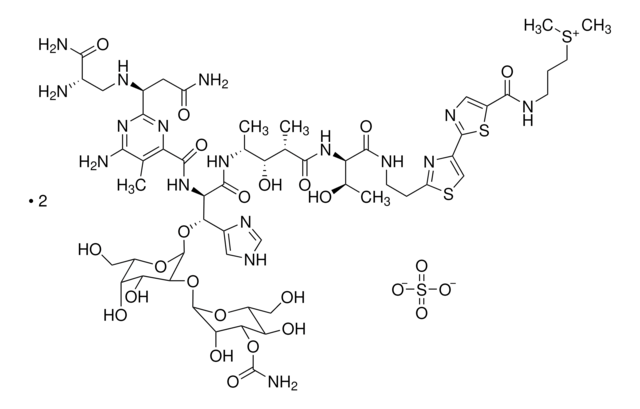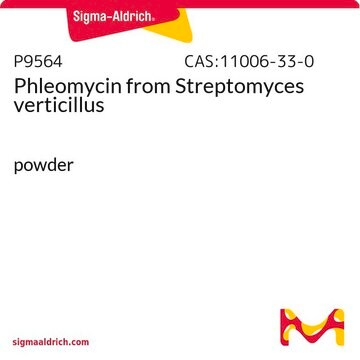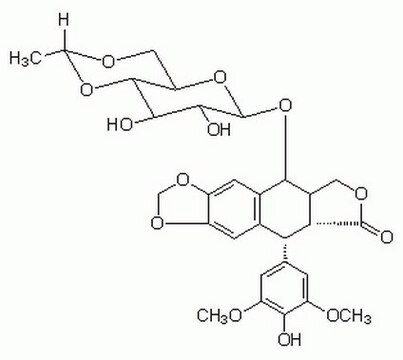B8416
Bleomycin sulfate from Streptomyces verticillus
crystalline, suitable for cell culture, BioReagent
Synonym(s):
Blenoxane, Bleo, Blexane
Select a Size
About This Item
Recommended Products
Product Name
Bleomycin sulfate from Streptomyces verticillus, 1.5-2.0 units/mg solid, BioReagent, suitable for cell culture
product line
BioReagent
Quality Level
form
powder or crystals
specific activity
1.5-2.0 units/mg solid
technique(s)
cell culture | mammalian: suitable
color
white to off-white
solubility
H2O: 20 mg/mL, clear, colorless
antibiotic activity spectrum
fungi
mode of action
DNA synthesis | interferes
Looking for similar products? Visit Product Comparison Guide
Related Categories
1 of 4
This Item | 1.37007 | 4.80791 | 1.37055 |
|---|---|---|---|
| agency Ph. Helv. | agency BP, ChP, JP, NF, Ph. Eur. | agency - | agency - |
| foreign activity Aflatoxin | foreign activity Aflatoxin | foreign activity Aflatoxin | foreign activity Aflatoxin |
| product line EMPROVE® EXPERT | product line EMPROVE® EXPERT | product line EMPROVE® EXPERT | product line EMPROVE® EXPERT |
| grade GMO free | grade GMO free, GMP, Halal, Kosher | grade GMO free, GMP, Halal, Kosher | grade GMO free, GMP, Halal, Kosher |
| vapor density 1.3 (vs air) | vapor density 1.3 (vs air) | vapor density 1.3 (vs air) | vapor density 1.3 (vs air) |
General description
Application
Biochem/physiol Actions
Components
Caution
Preparation Note
Other Notes
signalword
Danger
hcodes
Hazard Classifications
Carc. 2 - Muta. 1B - Repr. 2
Storage Class
6.1C - Combustible acute toxic Cat.3 / toxic compounds or compounds which causing chronic effects
wgk_germany
WGK 3
flash_point_f
Not applicable
flash_point_c
Not applicable
ppe
Eyeshields, Gloves, type P3 (EN 143) respirator cartridges
Choose from one of the most recent versions:
Certificates of Analysis (COA)
Don't see the Right Version?
If you require a particular version, you can look up a specific certificate by the Lot or Batch number.
Already Own This Product?
Find documentation for the products that you have recently purchased in the Document Library.
Customers Also Viewed
Articles
Antibiotic kill curve is a dose response experiment in which mammalian cells are subjected to increasing amounts of selection antibiotic
Our team of scientists has experience in all areas of research including Life Science, Material Science, Chemical Synthesis, Chromatography, Analytical and many others.
Contact Technical Service










